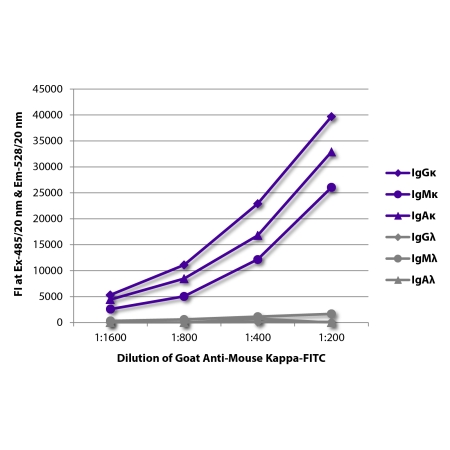Mouse Ig Kappa Chain Antibody : FITC
Cat# OASB01544
Size : 1.0mg
Brand : Aviva Systems Biology
| Datasheets/Manuals | Printable datasheet for OASB01544 |
|---|
| Tested Species Reactivity | Mouse |
|---|---|
| Clonality | Polyclonal |
| Isotype | IgG |
| Host | Goat |
| Conjugation | FITC: Fluorescein Isothiocyanate |
| Application | FLISA, FC, IHC-F, IHC-P, ICC, WB |
| Additional Information | Description: Pooled antisera from goats hyperimmunized with mouse kappa light chains; purified by affinity chromatography on mouse kappa light chains covalently linked to agarose; reacts with mouse kappa light chains; cross-adsorbed against mouse lambda light chains for minimal reactivity |
| Reconstitution and Storage | Store at 2-8C |
| Immunogen | Mouse kappa light chains |
| Purification | Affinity chromatography on pooled mouse Igs with- - light chains covalently linkedto agarose. |
| Concentration | 1.0 mg/mL |
| Specificity | Kappa |
| Characterization | To insure lot- to- lot consistency, each batch of product is tested by ELISA, FLISA, and/or flow cytometry forconformance with characteristics of a standard reference reagent. |
| Warning | Reagents contain sodium azide which is very toxic if ingested or inhaled. Avoid contact with skin, eyes, orclothing. Wear eye or face protection when handling. If skin or eye contact occurs, wash with copiousamounts of water. If ingested or inhaled, contact a physician immediately. Sodium azide yields toxichydrazoic acid under acidic conditions. Dilute azide- containing compounds in running water before discardingto avoid accumulation of potentially explosive deposits in lead or copper plumbing. |
| Dilution | ELISA: FLISA: AP conjugate HRP conjugate BIOT conjugate TRITC and TXRD conjugates 1:2,000-1:4,000 1:4,000-1:8,000 1:5,000-1:20,000 1:100-1:400 Immunofluorescence: Purified antibody FITC conjugates R-PE conjugate <= 1 ug/106 cells <= 1 ug/106 cells <= 0.1 ug/106 cells |
| Application Info | Enzyme-Linked-Immunosorbent-Assay (ELISA), Fluorescent-Linked-Immunosorbent-Assay (FLISA), Immunoblotting, Immunohistochemistry |
| Other Applications Data | Since applications vary, you should determine the optimum workingdilution of the product that is appropriate for your specific need. |
| Storage | - The purified (UNLB) antibody is supplied as 1.0 mg purified immunoglobulin in 1.0 mL of 100 mM boratebuffered saline, pH 8.2. No preservatives or amine- containing buffer salts added. Store at 2- 8 C - The fluorescein (FITC), rhodamine (TRITC), and Texas Red (TXRD) conjugates are supplied as 0.5 mgin 1.0 mL PBS/NaN3. Store at 2- 8 C - The alkaline phosphatase (AP) conjugate is supplied as 1.0 mL of stock solution in 50mM Tris/1mMMgCl2/50% Glycerol, pH 8.0, containing 0.1% NaN3 as preservative. Store at 2- 8 C or long- term at - 20 C - The horseradish peroxidase (HRP) conjugate is supplied as 1.0 mL of stock solution in 50% glycerol/50%PBS, pH 7.4. No preservative added. Store at 2- 8 C or long- term at - 20 C - The biotin (BIOT) conjugate is supplied as 1.0 mg in 2.0 mL PBS/NaN3. Store at 2- 8 C - The R- phycoerythrin (R- PE) conjugate is supplied as 0.25 mg in 1.0 mL of PBS/NaN3 and a stabilizingagent. Store at 2- 8 C. Do not freeze! - Protect fluorochrome- conjugated forms from light. Reagents are stable for the period shown on the label ifstored as directed. |
| Cross Absorption | Pooled mouse paraproteins with light chains. |
| Gene Symbol | IGK |
|---|---|
| Gene Full Name | Ig kappa chain C region |
| Alias Symbols | k, kappa |
| NCBI Gene Id | 243469 |
| Description of Target | Summary:Immunoglobulins recognize foreign antigens and initiate immune responses such as phagocytosis and the complement system. Each immunoglobulin molecule consists of two identical heavy chains and two identical light chains. There are two classes of light chains, kappa and lambda. This region represents the germline organization of the kappa light chain locus from the C57BL/6J inbred mouse strain. The locus includes V (variable), J (joining), and C (constant) segments. During B cell development, a recombination event at the DNA level joins a single V segment with a J segment; the C segment is later joined by splicing at the RNA level. Recombination of many different V segments with several J segments provides a wide range of antigen recognition. Additional diversity is attained by junctional diversity, resulting from the random additional of nucleotides by terminal deoxynucleotidyltransferase, and by somatic hypermutation, which occurs during B cell maturation in the spleen and lymph nodes. Several V segments in this cluster are incapable of encoding a protein and are considered pseudogenes. |
| Uniprot ID | P01837 |




